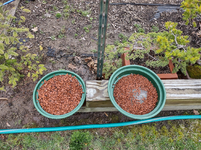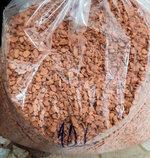I use it all the time.
For conifers.
For deciduous.
For tropicals.
A little less for azaleas, but still there.
Let's put it this way:
- We DON'T have Akadama being sold around here; not even the "bad", soft, mushy Akadama used in Japanese flower pots. No Akadama. At all.
- We DON'T have lava rock around here as there are no volcanoes in Brazil. In fact we do have some, imported from Chile or Argentina, but not easily available.
- We DON'T have pumice in granular sizes good enough for bonsai around here, only in powder, or in soap sized tablets used to scrape off dead skin on one's feet.
So...
Almost all bonsai growers in Brazil use "crushed bricks" in their mixes; I certainly do.
They are not really bricks, but high fired roof tiles crushed by machines developed specifically for that purpose. After controlled crushing, the granules are sifted, washed, packed and sold.
A typical mix here is "crushed bricks", matured pine bark, and number 2 sized river gravel, in different proportions according to the species being planted.
I also use - in some mixes - Perlite, Zeolite, Calcinated rice husk, horticultural charcoal, and a very good component (found only in tropical climates, I guess), which is crushed termite mounds (preferably from trees, not from the ground). It is a little darker than Akadama, changes color when wet, it's not very heavy, comes in 3mm to 5mm granules, pretty hard, good water and fertilizer retention, doesn't turn into mush. The only drawback is that it's difficult to find and it isn't cheap.
So yes, many people doing bonsai still use crushed bricks as a main soil component with very good results.



